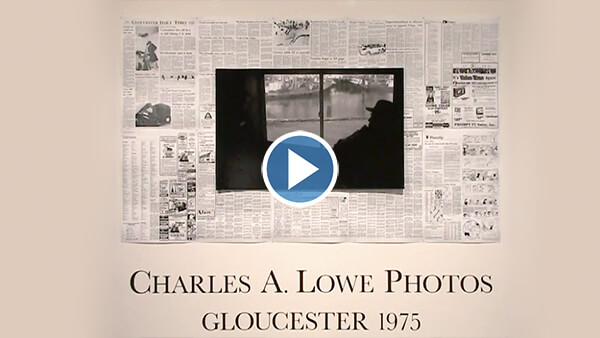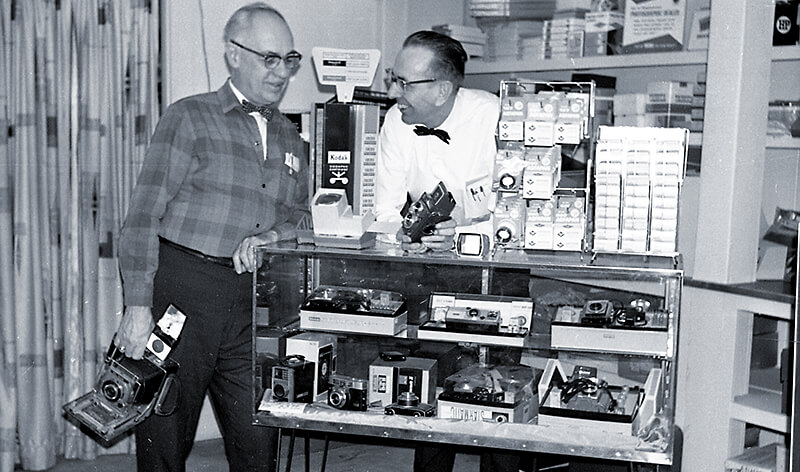
Harold Adams, Gloucester Camera & Photo, 97 Main Street, Gloucester, MA, c. 1950. Photograph by Barbara Erkkila. Collection of the Cape Ann Museum Library & Archives, Gloucester, MA.

Dear Friends,
In embarking on a dynamic new year at the Museum, it is with excitement that we share this first issue of CAM Connects for 2021!
I hope that you enjoy this insightful look into CAM’s extensive photography collections and that you will visit the current CAM (Re)Connects exhibit to see the defining role that photographs from the Museum’s holdings play to articulate each of the featured sections of the exhibition. To book your visit, please click here.
Looking forward to receiving your own photographic submissions via the Photograph Scavenger Hunt (below) and to welcoming you at both Museum campuses in 2021!

Oliver Barker, Director
Photography & Photographers
This issue of CAM Connects focuses on a few prominent photographers whose original negatives are held in the Cape Ann Museum's collection. The collection spans many decades and includes everything from early daguerreotypes to current day digital photos. The images range from fine art photographs to historical documentation to photojournalism to family snapshots.
With the ability to capture a distinct moment in time, photography has revolutionized the way society remembers its past and thanks to the contributions of the photographs and photographers in this issue, the way we remember Cape Ann. ■
Stereographs Arrive on Cape Ann
Stereograph cards are one of the many photography formats in the Museum’s collection. In this medium, two nearly identical photographic prints are mounted side by side on rigid paper cards. The cards were intended to be viewed using a stereoscope, a viewer that created the illusion of three-dimensional space, and were all the rage from about 1870 to 1920. Virtual reality from an earlier time!
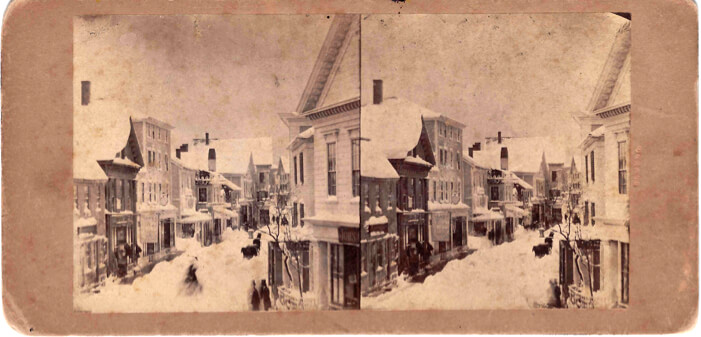
Front St., Gloucester. April 5, 1861. Published by William A. Elwell. Collection of the Cape Ann Museum Library & Archives, Gloucester, MA. Gift of the estate of Barbara H. Erkkila, 2014 [acc. #2014.28].
One of the first photographers to create stereograph cards here on Cape Ann was William Augustus Elwell (1827-1891) who, as early as 1861, was creating the cards and selling them from his shop on Front Street.
Elwell had started off as a painter and turned to photography mid-century, experimenting first with daguerreotypes before moving on to carte-de-visites and then to stereographs. Elwell’s work with the latter was heralded by the local press who in the spring of 1861 praised his artistic skills and proclaimed that “everyone in town possessing a stereoscope should endeavor to obtain duplicates of these views.” In coming years, others would join W. A. Elwell in publishing stereograph cards; among the most prolific was Procter Brothers who ran the Old Corner Bookstore at the corner of Front and Center Street in Gloucester.
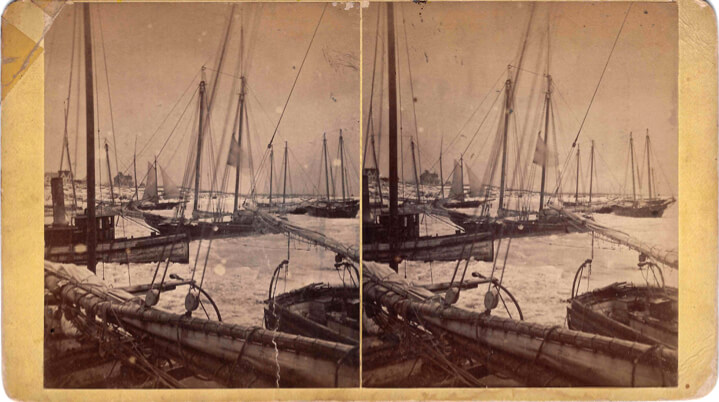
Gloucester Harbor, winter of 1875. Published by Procter Bros. Collection of the Cape Ann Museum Library & Archives, Gloucester, MA. Gift of the estate of Richard Souza, 2002 [acc. #2002.16].
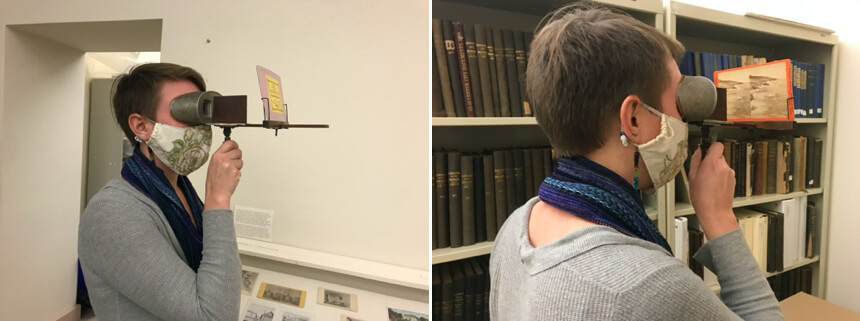
CAM Education Manager, Miranda Aisling, using the Library’s Stereoscope to experience the depth created by stereographs.
This is just one of the many early forms of photography in CAM’s collection. To learn more about the evolution of photography, visit this page by the Encyclopedia Britannica, and to view examples in the Library & Archives’ collection, contact us at library@capeannmuseum.org. ■
Ladies of the Lens:
Martha Hale Harvey and Eleanor Parke Custis
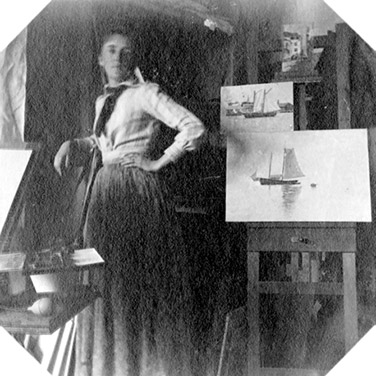
Martha Hale Harvey in the Annisquam studio she shared with her husband George Harvey, c. 1888. Photograph by her sister, Annie Rogers. Collection of the Cape Ann Museum Library & Archives, Gloucester, MA.
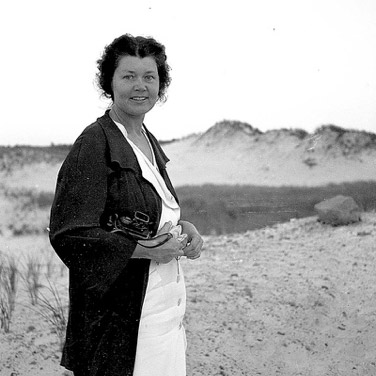
Eleanor Parke Custis, c. 1935. Custis Collection of the Cape Ann Museum Library & Archives, Gloucester, MA.
Focusing on photography in the Museum's collection offers the opportunity to look more closely at two women artists who explored that medium while working on Cape Ann. Although their lives overlapped in time, the rapid pace of technological developments in photography meant that Martha Hale Harvey (1863-1949) and Eleanor Parke Custis (1897-1983) each excelled in markedly different pictorial processes.
During the time that Martha Hale Harvey worked, the primary process for taking photographic images entailed exposing gelatin coated glass plate negatives to create albumen silver prints. From an artistic perspective, photographers at this time were beginning to explore the aesthetics of the medium rather than focusing on the capabilities of the scientific process, and Harvey joined in with the emerging taste for more naturalistic images in which the picture itself was viewed as a legitimate form of artistic expression. View more of her work here.
When Eleanor Parke Custis was given a Kodak Brownie camera at age twelve, photographic equipment had evolved into a relatively small hand-held unit that was preloaded with flexible film. Custis experimented with developing her own prints and enlargements, often utilizing the “Flou-Net” (Soft-Sharp) enlarging diffuser patented in 1931 by Leonard Misonne to soften an image’s focus and create halos along shadow edges. Custis received considerable acclaim for her photographs during her lifetime and was elected an Associate of the Photographic Society of America in 1937. View more of her work here. ■
Sculpting with Color

Leonard Craske photographing his statue, “Man at the Wheel,” on the Boulevard, Gloucester, MA, c. 1940. Photograph by Eleanor Parke Custis. Collection of the Cape Ann Museum Library & Archives, Gloucester, MA.
During the early 20th century, the only opportunity most traditional sculptors had to incorporate color into their work was to decide between a green or brown patina. Perhaps that’s why Leonard Craske, who is best known for his 1923 Gloucester Fisherman’s Memorial (known as the Man at the Wheel), turned toward the medium of photography as a means to explore color.
Color photography was still relatively new and expensive when Craske began experimenting with it in the early 1930s. His subject matter was often local: dramatic sunsets over the harbor, the foggy moors of East Gloucester, sundrenched beaches, rose gardens and ponds with waterlilies, all in living color. True to the spirit of the sculpture for which he is remembered, he also took photographs of fishermen, trawling, and gillnetting. Continue reading here. ■
Camera Club and Herman W. Spooner
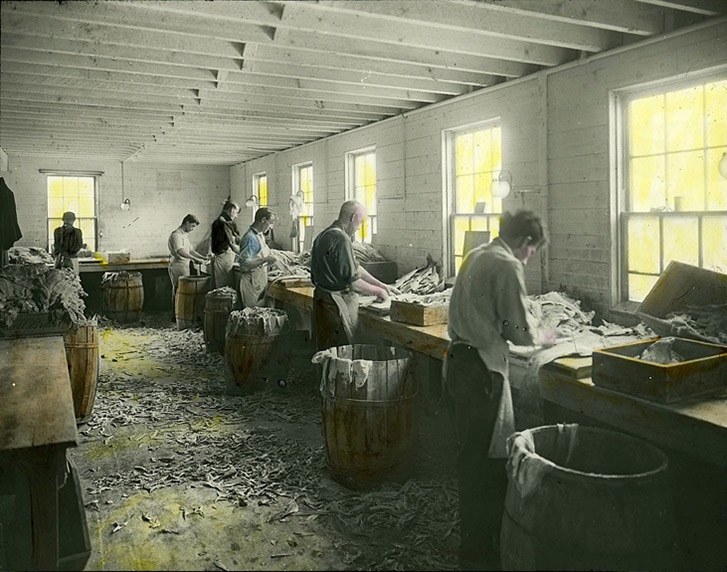
Fish skinning at Sylvanus Smith & Co., Gloucester, MA. Herman W. Spooner hand-tinted lantern slide, c. 1900. Collection of the Cape Ann Museum Library & Archives, Gloucester, MA.
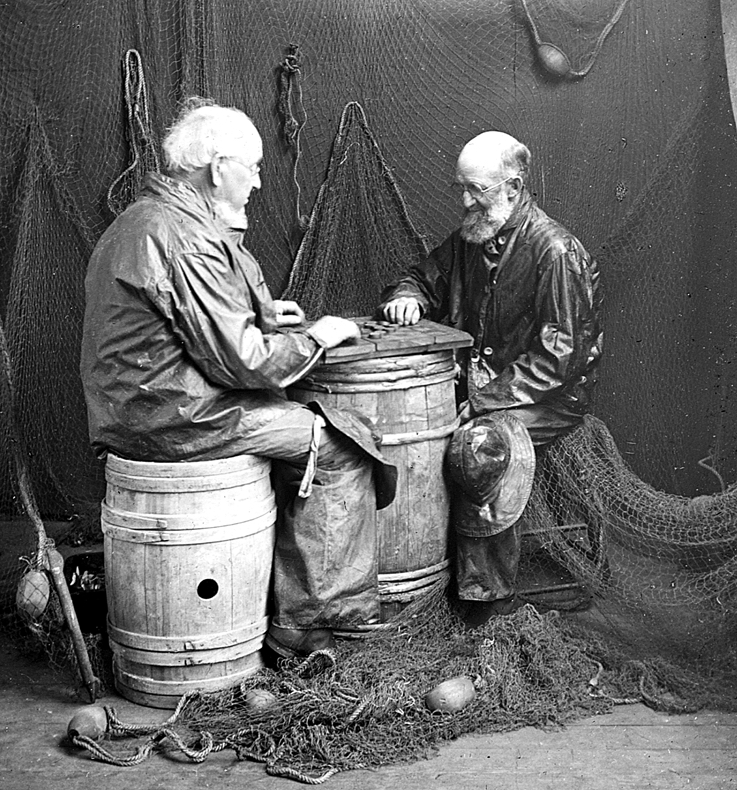
Herman W. Spooner photograph from his “Old Salt” series of David Stanwood and Lemuel Friend and the Cape Ann Camera Club studio at 119 Main St. Collection of the Cape Ann Museum Library & Archives, Gloucester, MA.
Before digitization and social media offered the world of photography at our fingertips, how did photographers connect and find inspiration from each other’s work? Locally, they had the Cape Ann Camera Club!
The Cape Ann Camera Club was organized in 1902, and its members wrote their constitution in 1903. The club rented rooms at 119 Main St., Gloucester until it ended in 1947. The original purpose of the club was “... the advancement among its members of the knowledge of photography in all its branches and the promotion of social intercourse among those interested in photography.” The “social intercourse” was greatly expanded with a billiard table, ping pong table, bridge contests, catered bi-monthly meetings and banquets to entertain the club’s over two-hundred known members.
One of its charter members was Herman W. Spooner (1870-1941), and you have probably seen one of his photographs from the Museum’s Library & Archives in either our publications or social media posts. Continue reading here. ■
Processing the Charles A. Lowe Collection

Grand opening of King's Department Store in East Gloucester Shopping Center, Bass Ave. at Thatcher Road. Photograph by Charles A. Lowe for the Gloucester Daily Times. Collection of the Cape Ann Museum Library & Archives, Gloucester, MA.
“It's easy to take a beautiful picture of beautiful things, and it's easy to take compelling pictures of compelling situations. But it's very, very difficult to take interesting pictures of everyday life. And that's what Charlie did. And you look at his pictures and his pictures will teach you everything you need to know about photography just by looking at them.”
-Photographer Nubar Alexanian, during a 2009 presentation on Charlie Lowe.
In 2004, the Cape Ann Museum Library & Archives received the generous donation of photographs by Gloucester Daily Times photographer, Charles A. Lowe. Charlie’s photographs are well known and much beloved by the Cape Ann community, and this collection of photographs, ranging from 1973 to 1981, is a window into the community’s day to day life for almost a decade.
Over the course of the following years, the Museum worked to process, digitize, exhibit, and share this incredibly important collection of images. Thanks to the foresight of Museum staff and cameraman Bob Quinn, we’re lucky enough to be able to walk through that 2009 exhibit once again:
The week before this walkthrough was recorded, a few individuals, including past editor of the GDT Peter Watson, spoke about Lowe’s work and importance to Gloucester. That lecture, VL18: Award Winning Photos by Charles Lowe in the 1970s, can be viewed here.
But none of this would have been possible without the dedication and expertise of CAM’s Photo Archivist, the late Fred Buck. Fred was a champion of not only Charlie’s work, but all local photographers, as is evidenced by the tens of thousands of digitized photographs in CAM’s collection. Upon completion of processing the Lowe collection, Fred took a moment to share what the photographer meant to him and his life:
“In the summer of 1969, my wife and I spent three months in Gloucester staying with my mother who had moved into an apartment on Fort Square a few doors down from poet Charles Olson, who was an old family friend from our days at Black Mountain College. Chatting in the street outside his house one day, Charles opened up a copy of the Gloucester Daily Times he was carrying and pointed to a photo on the front page. He said, “See that? That’s Charlie Lowe’s. You study that guy – he knows more about Gloucester than any of the scribblers in here…” I don’t remember what the photo was, but I’m sure it was a corker. Most of them were. When we moved to Gloucester the following year I studied Charlie Lowe every time I opened the newspaper – not because someone told me to, but because his photographs were headturners, and often had more to say than the thousand words that went with them…”
Continue reading Fred’s note on page 6 of the Charles A. Lowe Negatives and Photographs Collection Finding Aid. ■
Photograph Scavenger Hunt

Photo Scavenger Hunt inspirations. Left to right: Thacher Island Twin Lights, 1916. Photograph by Herman W. Spooner; Salt Hay Stack in Essex Marsh, c. 1890s. Photograph by Martha Hale Harvey; Gill Nets on Reels on Wharf, East Gloucester, c. 1910. Photograph by Herman W. Spooner; Leonard Craske next to his monument, the Fisherman's Memorial, c. 1940s. Photograph by Donald Hults.

Photo Scavenger Hunt submissions by CAM Staff.
Has this week’s CAM Connects issue inspired you to take some photos of your own? Then join us on a CAM Photo Scavenger Hunt! Here are four prompts for you to find and document through your lens: (1) Cape Ann sunset, (2) tracks in the snow, (3) weathered beauty, and (4) The Man at the Wheel.
Email your submissions to education@capeannmuseum.org or use the hashtag #CAMPhotoHunt and direct message us your photos on Facebook or Instagram (@capeannmuseum) by January 23 and your photo might be featured in a future social media post by the Museum!
And be sure to pick up even more photography inspiration from these books in the CAM Shop! ■
Unsubscribe | Forward | View in browser
CAPE ANN MUSEUM
27 Pleasant Street, Gloucester, MA 01930
CAPE ANN MUSEUM GREEN
13 Poplar Street, Gloucester, MA 01930
Cape Ann is one of the most important places in the history of American art and industry.
The Cape Ann Museum, thanks to supporters like you, celebrates the history and remarkable contributions of this place to the cultural enhancement of our community and the world at large - yesterday, today and tomorro


